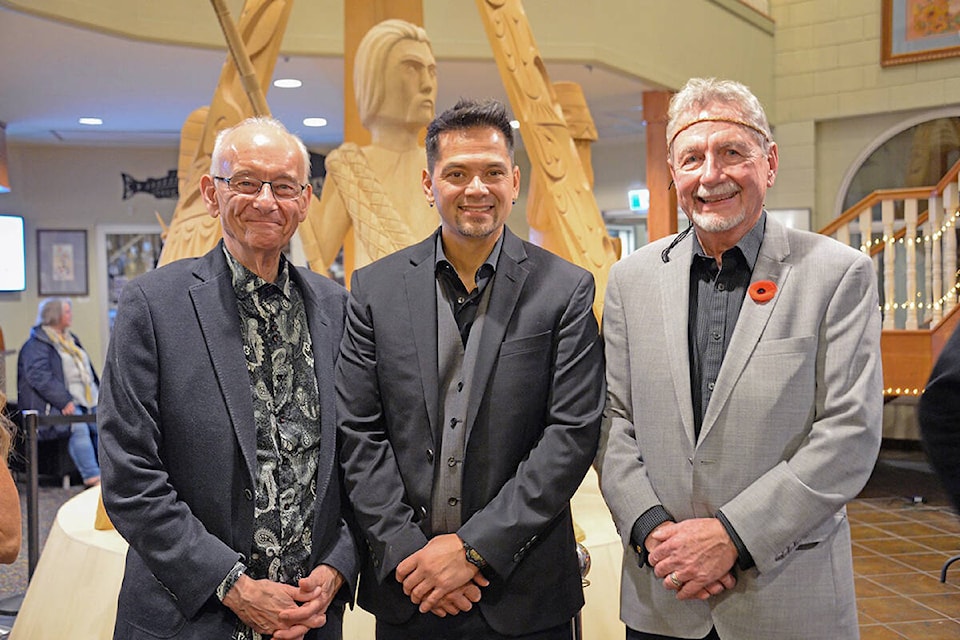BY DUCK PATERSON
A Stz’uminus artist’s signature piece and his personal story of how it came to be are the subjects of a new documentary.
Shore to Shore, a film about the carving of the same name, was shown earlier this month at the Chemainus Theatre. The documentary film by Peter Campbell from Gumboot Productions in Victoria follows Luke Marston, Ts’uts’umutl, and his thought process and work on a sculpture representing the life and experiences of his great-great-grandfather, Joe Silvey, and his connection to the Coast Salish people, whalers and pioneers of the area.
“My work is a reflection of the respect I feel for the master carvers of long ago. I believe that we have to find a balance between traditional and contemporary art, and at the same time evolve and grow as Coast Salish people,” said Marston.
READ ALSO: Shore To Shore sculpture adorns theatre lobby
The Shore to Shore bronze sculpture was officially unveiled in the spring of 2015 in Vancouver’s Stanley Park. Marston had worked for almost five years on the piece, which depicts his great-great-grandparents, Joe Silvey and his second wife Kwatleematt (Lucy), a Sechelt First Nation matriarch, and Khaltinaht, Silvey’s first wife, from the Musqueam and Squamish First Nations.
Marston’s parents introduced him to carving. He learned Salish history and traditional stories from the late Coast Salish artist Simon Charlie, and honed his talents in form, design and carving detailed finishing from Haida-Nisga’a artist Wayne Young. He also spent time researching and studying old Salish works in the archives and historical collections of museums.
Marston said the idea of the Joe Silvey project came about after his family watched a documentary about Silvey, “one of B.C.’s colourful pioneers,” and talked about some sort of memorial for him in Stanley Park, where he and his wife had lived. After meetings with other interested parties, including the Portuguese consulate, the not-for-profit Portuguese Joe Memorial Society was formed with the goal of memorializing Silvey and his wives and the contributions he made on the West Coast.
“There really was nothing set in stone, but I started putting sketches together and it prospered from there,” Marston said.
Jean Barman had written a book titled The Remarkable Adventures of Portuguese Joe Silvey and a lot of the history and characters that would go into the design of the sculpture were garnered from that work, Marston said. The book includes history of Khaltinaht, whose grandfather was the respected Chief Kiapilano. After Khaltinaht died, Silvey remarried and he and Kwatleematt lived in Sechelt.
The three figures in the piece are gathered around an Indigenous cod lure. One of Marston’s mentors, Charlie, integrated cod lures into a lot of designs, and Marston felt that it would be more interesting than a long house pole or other more standard art forms. The lure is shaped like Pico Mountain in the Azores off the coast of Portugal.
“We spent 10 days in the Azores, mostly on Pico Island which is where Luke’s great-great-grandfather was born,” said the filmmaker Campbell. “Some of the locations included the whaling museum, Pico Mountain, a community gathering where Luke discussed the project and then out on the Atlantic in a whaling skiff, similar to what his great-great-grandfather would have used.”
The original sculpture of the Portuguese Joe memorial is carved out of yellow cedar. Marston enlisted the help of his brother and two other carvers on the project. Once all the components of the cedar were done, bronzesmith Steve Harman of Red Deer, Alta., created bronze moulds which he filled with wax, covered in plaster, then filled with molten bronze. Once cooled, the solid bronze sculpture required some finishing and polishing. The sculpture was completed in pieces and welded together.
“Although it wasn’t my intent in getting involved in this aspect of the project – it wasn’t really, I thought, a part of me – after a while I found myself working for a few weeks at a time and we finished,” said Marston.
In addition to the creation of the artwork, there were other aspects to the project – a lot of meetings, paperwork, and finding a way to pay for everything. Trying to get a sculpture into Vancouver is really tough, Marston said, and he was told at the outset that getting a sculpture into Stanley Park is next to impossible.
“I was also informed that approval from the Musqueam, Squamish and Tsleil-Waututh nations was also required as the lands are part of their traditional territories,” he said. “I knew that and knew the protocols and approached each community. The support from the three was overwhelming.”
The final stages of the project were exciting, the artist said.
“Issues arose over the length of the project, including my brother-in-law passing away; my mother had open-heart surgery. I was working constantly to get it done, I still loved what I was doing, but the stresses were also mounting…” Marston said. “We had such a push at the end. I stayed at the foundry towards the end and then we drove it all back to the site. It felt super good.”
READ ALSO: Ladysmith carver caps five-year journey with landmark statue
Campbell said the process presented itself in chapters: the decision of the family to go forward with the project; the gathering of the materials, research, development and design; the creation of the miniature; travelling to the Azores; engaging the community; carving the seven main elements of the piece; casting the sculpture in bronze; site selection; and installation and unveiling.
Campbell said the project left him “dizzy” and took a year of editing to unravel the material into a 40-minute story.
“I saw the project as a great opportunity to document an important work of art with powerful historical and social significance,” he said. “It was also a love story, and a story of cross-cultural understanding and respect.”
The film is available at http://vimeo.com/ondemand/shoretoshore.
